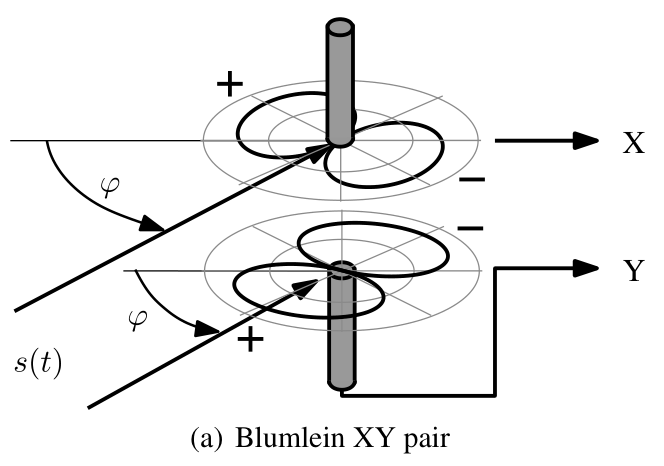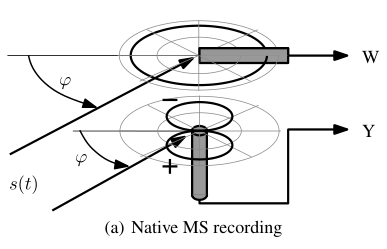MAN Wiki
Stereophonic (Rev #2, changes)
Showing changes from revision #1 to #2:
Added | Removed | Changed
Stereo microphone systems 1
A-B (delay-based)
A-B microphone system uses two parallel omnidirectional? microphones with a clear distance.
X-Y Blumlein pair and X-Y stereo in general (intensity-based, coincident)
Blumlein pair uses the setup of 90 angled crossed figure-of-eights microphones. According to Michael Gerzon, the Blumlein pair system has a most remarkable stereo stability.
A classic Blumleinian coincident microphone pair uses two figure-of-eight microphones pointing to , in other words, two microphones are positioned from each other.

The pickup pattern of a classic Blumleinian microphone pair can be defined as:
where is the angle of the sound source relative to the microphone pair, is the response of the Blumlein microphone pair to sound signals at different angles of incidence , and represents the front-right signal, while represents the front-left one.
Assuming a signal originates from an angle of , the pickup signals’s gain can be expressed as:
As the sound source moves from the right channel at an angle of to the left channel at an angle of , the captured signal would be panned from the channel to the channel , the transition can be represented as follows:
Sound comes from the sides that have angles ranged from to and certainly also to will make a Blumleinian microphone pair producing out-of-phase signals between and channels.
Compared to a A-B way of setup, the sonic characteristic of a Blumleinian microphone pair has less sense of space and depth.
ORTF: (near-coincident)
ORTF (Office de Radiodiffusion Télévision Française) is a variation on the basic X-Y coincident technique, which uses two cardioid microphones spaced 7 inches (17 cm) apart and facing outward with an angle of between them.
M-S: (intensity-based)
The M/S technique employs a mid (omnidirectional?, sometimes cardioid?-directional to front) cartridge that directly picks up the mono sum signal, and a side (figure-of-eight) cartridge that directly picks up the stereo difference signal.
A native MS recording pair uses a pair of omnidirectional microphone (mid, ) and figure-of-eight microphone (side, ).

The pickup pattern of this MS microphone pair can be defined as:
where is the angle of the sound source relative to the microphone pair, is the response of the MS microphone pair to sound signals at different angles of incidence , and represents the mid signal, while represents the side signal.
Assuming a signal originates from an angle of , the pickup signals’ gain can be expressed as:
External resource
- https://www.michaelgerzonphotos.org.uk/
- SCHOEPS Double MS Plugin (Plug in for dematrixing double MS recordings): https://tonsturm.com/product/schoeps-double-ms
References
[1] Zotter, Franz & Frank, Matthias. (2019). Ambisonics: A Practical 3D Audio Theory for Recording, Studio Production, Sound Reinforcement, and Virtual Reality. 10.1007/978-3-030-17207-7. Download: https://link.springer.com/content/pdf/10.1007/978-3-030-17207-7.pdf
[2] Ballou, G. (Ed.). (2009). Electroacoustic Devices: Microphones and Loudspeakers (1st ed.). Routledge. https://doi.org/10.4324/9780240812687
-
This entry mainly developed its content by re-structuring Zotter & Frank
ComprehensivecomprehensivespringerSpringer handbook of Ambisonics. Also figures come from this book.↩